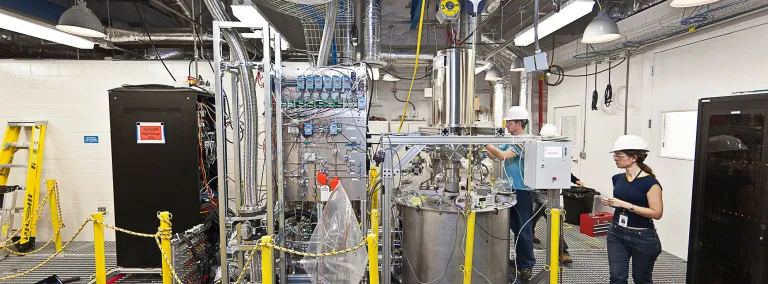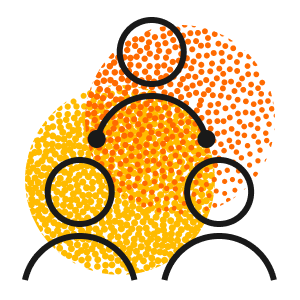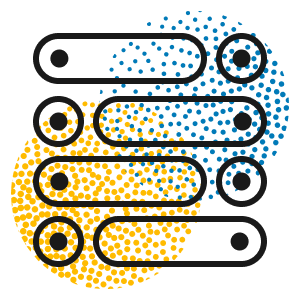
Present
LUX-ZEPLIN
LUX-ZEPLIN (LZ) became the world's most sensitive dark matter detector with the announcement of first results on July 7, 2022.
Deep below the Black Hills of South Dakota in the Sanford Underground Research Facility (SURF), LZ is an innovative and uniquely sensitive dark matter experiment led by Lawrence Berkeley National Lab (Berkeley Lab). The LZ collaboration includes approximately 220 participating scientists and engineers representing 38 institutions around the world. LZ is 100 times more sensitive to finding signals from dark matter particles than its predecessor, the Large Underground Xenon experiment (LUX), which was decommissioned to make way for LZ.
What are WIMPs?
WIMPs (weakly interacting massive particles) are among the top prospects for explaining dark matter.
Unseen, because it does not emit, absorb, or scatter light, dark matter’s presence and gravitational pull are nonetheless fundamental to our understanding of the universe. For example, the presence of dark matter, estimated to be about 85 percent of the total mass of the universe, shapes the form and movement of galaxies, and it is invoked by researchers to explain what is known about the large-scale structure and expansion of the universe. This “missing mass” is considered to be one of the most pressing questions in particle physics.
How does the experiment work?
Tucked away about a mile underground at SURF in Lead, S.D., LZ is designed to capture dark matter in the form of weakly interacting massive particles (WIMPs). The experiment is underground to protect it from cosmic radiation at the surface that could drown out dark matter signals.
Particle collisions in the xenon produce visible scintillation or flashes of light, which are recorded by the PMTs, explained Aaron Manalaysay from Berkeley Lab who, as physics coordinator, led the collaboration’s efforts to produce these first physics results. “The collaboration worked well together to calibrate and to understand the detector response,” Manalaysay said. “Considering we just turned it on a few months ago and during COVID restrictions, it is impressive we have such significant results already.”
“Turning on a new experiment is challenging, but we have a great LZ team that worked closely together to get us through the early stages of understanding our detector”
The collisions will also knock electrons off xenon atoms, sending them to drift to the top of the chamber under an applied electric field where they produce another flash permitting spatial event reconstruction. The characteristics of the scintillation help determine the types of particles interacting in the xenon.
The South Dakota Science and Technology Authority, which manages SURF through a cooperative agreement with the U.S. Department of Energy, secured 80 percent of the xenon in LZ. Funding came from the South Dakota Governor’s office, the South Dakota Community Foundation, the South Dakota State University Foundation, and the University of South Dakota Foundation.
Fiorucci said the onsite team deserves special praise at this startup milestone, given that the detector was transported underground late in 2019, just before the onset of the COVID-19 pandemic. He said with travel severely restricted, only a few LZ scientists could make the trip to help on site. The team in South Dakota took excellent care of LZ.
Maria Elena Monzani of SLAC, the Deputy Operations Manager for Computing and Software, said “We had amazing scientists and software developers throughout the collaboration, who tirelessly supported data movement, data processing, and simulations, allowing for a flawless commissioning of the detector. The support of NERSC [National Energy Research Scientific Computing Center] was invaluable.”

220 scientists from 38 institutions
Scientists from around the world come to SURF to work on the LUX-ZEPLIN dark matter experiment

—160 Degrees
In the search for WIMPs, scientists with LZ use 10 metric tones of super dense liquid xenon, which is cooled by liquid nitrogen to -160 Fahrenheit.
What’s next for LZ?
With confirmation that LZ and its systems are operating successfully, Lesko said, it is time for full-scale observations to begin in hopes that a dark matter particle will collide with a xenon atom in the LZ detector very soon.
LZ spokesperson Hugh Lippincott of the University of California Santa Barbara said, “We plan to collect about 20 times more data in the coming years, so we’re only getting started. There’s a lot of science to do and it’s very exciting!”

